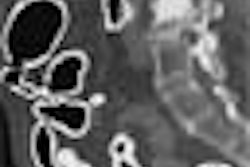Chest CT is more sensitive than x-ray for detecting lung metastases of head and neck malignancies, but does earlier detection translate into better patient outcomes? U.K. researchers set out to answer this question in a recent prospective study. They presented their results at the 2002 American Academy of Otolaryngology-Head and Neck Surgery Foundation meeting in San Diego.
The study cohort consisted of 44 patients, 30 men and 14 women (average age 67), who had been diagnosed with squamous cell carcinoma of the head or neck. All underwent both chest x-ray and chest CT at the same time they underwent CT of the primary tumor site.
One patient had a true-positive finding from the chest x-ray and five patients had abnormal chest CT scans. Among the five abnormal results, three were true positives: two patients had multiple metastatic lung lesions, and another had a bronchogenic carcinoma. The sensitivity of chest CT was 100%, and specificity was 95%. In comparison, x-ray turned in 33% sensitivity, and specificity of 97%.
"We found on the CT scans that patients had secondary deposits of the primary lesion that we weren’t able to detect by x-ray. The main concern about CT scans, though, is the risk of false positives," said lead author Dr. Perumkulam Arunchalam, a senior resident in otolaryngology at Cumberland Infirmary in Carlisle, U.K. His co-author was Dr. Andrew Robson, consultant head and neck surgeon at Cumberland.
Commenting on the U.K. study, Dr. Eric Hart, an assistant professor of radiology and director of thoracic imaging at Northwestern University’s Feinberg School of Medicine in Chicago, agreed that the false-positive rate of CT is a concern.
"There are a couple of important issues that this study raises. Do we know that finding lesions in the chest sooner will alter the patient’s outcome, be they head and neck metastases or primary lung cancers? We don’t know if earlier detection is positive or negative," said Hart, who also is a staff radiologist at Northwestern Memorial Hospital.
"Radiologists need to remember that false positives are not trivial events," Hart added. "The risk of false positives has to be balanced with the overall patient situation. In our practice, we are hoping to do a study comparing low-dose CT and chest x-ray in these patients to see if we can alter their management."
The researchers’ findings show that radiologists need to communicate effectively with their colleagues in head and neck surgery, he said.
"In an ideal world, we would use results of studies like this one and call the referring physician, and make an alternate recommendation if the physician ordered a chest x-ray," he said. "In the realistic world, it may take more studies with larger patient groups to convince everyone that this may be the way to proceed."
The Cumberland group is planning to collect data from throughout the U.K. in order to establish a larger database for a multicenter trial comparing the two modalities.
By Paula MoyerAuntMinnie.com contributing writer
October 18, 2002
Related Reading
CT, x-ray to face off in lung cancer screening megatrial, September 19, 2002
In-line PET-CT system improves cancer diagnosis, October 10, 2002
CAD highlights hazy opacities on chest x-rays, October 11, 2002
Therapy-eluding metastases caught with FDG-PET, October 3, 2001
Copyright © 2002 AuntMinnie.com




















